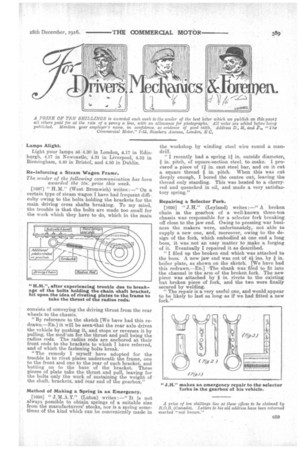A PRIZE OP TEN SHILLINGS is awarded each week to
Page 19

If you've noticed an error in this article please click here to report it so we can fix it.
the sender of the best letter which we publish on this page: all others paid for at the rate of a penny a line, with an allowance for photographs. AR notes are edited before being publiohed. Mention your employer's name, in confidence, as evidence of good faith. Address D., M, and E., "110 Commercial Motor," 7-15, Roseberv Avenue, London, E C,
Lamps Alight.
Light your lamps at 4.30 in London, 4.17 in Edinburgh, 4.17 in Newcastle, 4.31 in Liverpool, 4.32 in Birmingham, 4.40 in Bristol, and 4.50 in Dublin.
Re-inforcing a Steam Wagon Frame.
The sender of the following communication, has been. awarded the 108. prize this week.
[1697] " H.M." (West Bromwich) writes :—" On a certain type of steam wagon I have had frequent difficulty owing to the bolts holding the brackets for the main, driving cross shafts breaking. To my mind, the trouble is that the bolts are made too small for the work which they have to do, which in the main consists of conveying the driving thrust from the rear wheels to the chassis.
"By reference to the sketch [We have had this redrawn.—En.] it will be seen -that the rear axle drives the vehicle by pushing it and stops or reverses it by pulling, the med'am for the thrust and pull being the radius rods. The radius rods are anchored at their front ends to the brackets to which I have referred, and of which the fastening bolts break.
"The remedy I myself have adopted for the trouble is to rivet plates underneath the frame, one to the front and one to the rear of each bracket, and butting on to the base of the bracket. These pieces of plate take the thrust and pull, leaving for the bolts only the work of sustaining the weight of the shaft, brackets, and rear end of the gearbox."
Method of Making a Spring in an Emergency.
[1698] " J.M.A.Y." (Luton) writes :—" It is not always possible to obtain springs of a suitable size from the manufacturers' stocks, nor is a spring sometimes of the kind which can be conveniently made in the workshop by winding steel wire round a mandrill.
" I recently had a spring Li in. outside diameter,.
in. pitch, of square-section steel, to make. I procured a piece of 14 in. cast steel bar, and on it cut a square thread j in. pitch. When this was cut deeply enough, I bored the centre out, leaving the thread only standing. This was heated to a cherryred and quenched in oil, and made a very satisfactory spring."
Repairing a Selector Fork.
[1699] " J.H." (Leyland) writes :—" A broken chain in the gearbox of a well-known three-ton chassis was responsible for a selector fork breaking off close to the jaw end. Owing to pressing war business the makers were, unfortunately, not able to supply a new one, and, moreover, owing to the design of the fork, which embodied at one end a long boss, it was not an easy matter to make a forging of it. Eventually I repaired it as described.
"I filed up the broken end which was attached to the boss. A new jaw end was cut of 4i ins, by in. boiler plate, as shown on the sketch. [We have had this redrawn.—En.] The shank was filed to fit into the channel in the arm of the broken fork. The new piece was attached by in. rivets, to the existing but broken piece of fork, and the two were finally secured by welding. " The repair is a very useful one, and would appear to be likely to last as long as if we had fitted a new fork."




















